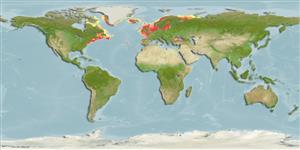Classification / Names
Common names from other countries
Main reference
Size / Weight / Age
Max length : 150 cm TL male/unsexed; (Ref. 7251); 120.0 cm TL (female); common length : 38.0 cm TL male/unsexed; (Ref. 3561); max. published weight: 46.8 kg (Ref. 41037); max. reported age: 13 years (Ref. 274)
Length at first maturity
Lm 73.1 range ? - ? cm
Environment
Marine; freshwater; brackish; benthopelagic; anadromous (Ref. 92381); depth range 0 - 210 m (Ref. 57178), usually 10 - 23 m
Climate / Range
Temperate; 2°C - 9°C (Ref. 36794), preferred 10°C (Ref. 107945); 72°N - 37°N, 77°W - 61°E (Ref. 54253)
Distribution
North Atlantic Ocean: temperate and arctic zones in northern hemisphere (Ref. 51442).
In the western Atlantic, it ranges from western Greenland and the coastal drainages of Quebec, Canada, to Connecticut, USA (Ref. 5723). Landlocked stocks are present in North America (Ref. 1998). In the eastern Atlantic, it ranges from the White and Barents Sea basins through northeastern Europe to the Baltic and North Sea basins, including Iceland (Ref. 59043). Introduced to New Zealand, Chile, southern Argentina (Ref. 59043) and Australia (Ref. 6390).
Listed in Appendix III of the Bern Convention (2002) (freshwater only).
Listed in Annex II (freshwater only; excluding Finnish population) and V (freshwater only) of the EC Habitats Directive (2007).
Countries | FAO areas | Ecosystems | Occurrences | Introductions
Short description
Dorsal
spines
(total): 3 - 4;
Dorsal
soft rays
(total): 9-15;
Anal
spines: 3-4;
Anal
soft rays: 7 - 11;
Vertebrae: 58 - 61. Distinguished from congeners by having the following unique characters: 10-13 scales between end of adipose base and lateral line; 17-24 gill rakers (Ref. 59043); caudal fin deeply forked in individuals smaller than 20 cm SL; hyaline or grey adipose margin; posterior part of vomer toothless (Ref. 59043). Mouth extends only to area below rear of eye and has well developed teeth (Ref. 51442). Vomerine teeth weak (Ref. 7251). Caudal fin with 19 rays (Ref. 2196). Little scales (Ref. 51442). Juveniles have 8-12 blue-violet spots on the flanks with little red spots in-between (Ref. 51442). Adults at sea are bluish-green dorsally becoming silvery along the sides and white ventrally; with a few black spots but none under lateral line (Ref. 37032, Ref. 51442). Caudal fin usually unspotted and adipose fin not black bordered. During reproduction individuals lose the silvery shine and become dull brown or yellowish. Males may be mottled with red or have large black patches (Refs. 37032, 51442, 88171). Skin becomes thick and leathery. Survivors lose their spawning coloration and are generally dark in colour (Ref. 84357). During the spawning season, males are characterized by elongated hooked jaws that meet at the tips, thicker fins, and slime covering their body. Hook of males dwindle after spawning (Ref. 35388).
IUCN Red List Status (Ref. 115185)
Threat to humans
Harmless
Human uses
Fisheries: highly commercial; aquaculture: commercial; gamefish: yes
Tools
Special reports
Download XML
Internet sources
Estimates of some properties based on models
Phylogenetic diversity index
PD50 = 0.5000 many relatives (e.g. carps) 0.5 - 2.0 few relatives (e.g. lungfishes)
Trophic Level
4.5 ±0.3 se; Based on diet studies.
Resilience
Medium, minimum population doubling time 1.4 - 4.4 years (K=0.1-0.2; tmax=6; Fecundity=1,600)
Vulnerability
High vulnerability (62 of 100)
Price category
